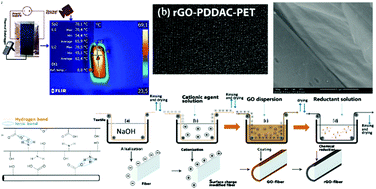The role and importance of surface modification of polyester fabrics by chitosan and hexadecylpyridinium chloride for the electrical and electro-thermal performance of graphene-modified smart textiles
Abstract
Graphene has the potential to create highly valuable electrical conductive textile systems with maintained pliability and psychological comfort. There have already been numerous studies regarding electrically functionalized graphene-coated textiles. However, processing development is far from being exhausted. Here we have studied electro-thermal textiles based on the most common fibers, polyester, and an industry-relevant graphene impregnation method by introducing surface pre-modification of fabrics for graphene-modified textile processing. For this purpose, polyester fabrics were treated with four different cationic agents and impregnated with graphene oxide (GO) colloidal particles. Then, direct chemical reduction of GO to an electrically conductive graphene oxide (rGO) was performed. A pristine fabric modified by rGO showed a high resistance of 27.3 kΩ □−1 without any electro-thermal activity, whilst chitosan-treated (CS) and hexadecylpyridinium chloride-treated (HDPC) fabrics had resistance values of 2.7 and 0.59 kΩ □−1 respectively, and excellent heat propagation with a good temperature distribution. The steady-state temperature of CS-treated and HDPC-treated fabrics increased from 28 °C and 33 °C to 60 °C and 120 °C, respectively, as the voltage applied increased from 10 V to 30 V. These rGO-modified fabrics also have excellent electro-mechanical performance, and are good candidates for flexible strain sensor applications.



 Please wait while we load your content...
Please wait while we load your content...